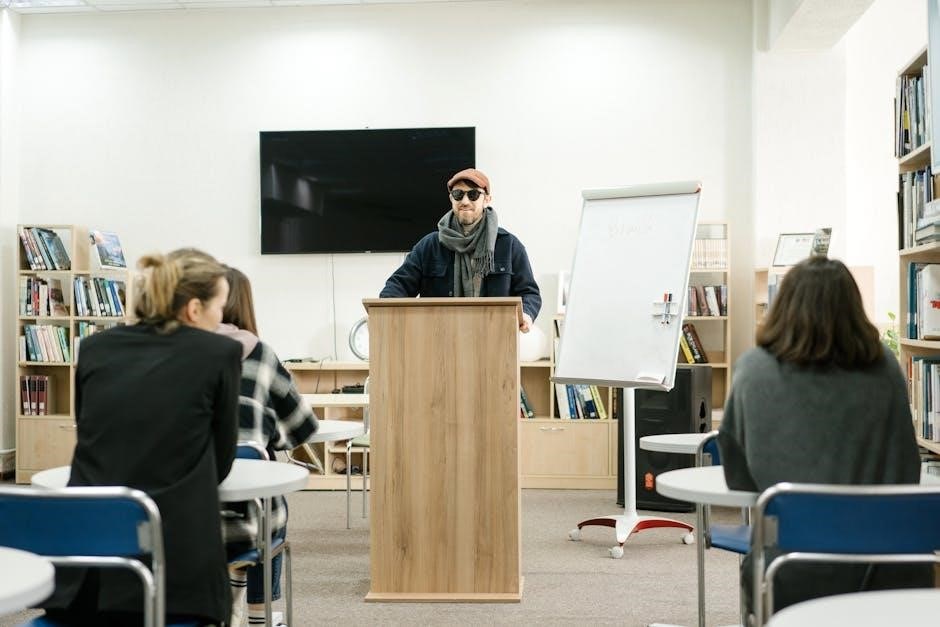Transformations are fundamental in geometry, involving changes in position, size, or orientation of figures. They are essential for understanding spatial relationships and problem-solving in math.
1.1 Definition and Importance of Transformations in Geometry
Transformations in geometry involve changes in the position, size, or orientation of figures. They are essential for understanding spatial relationships and problem-solving. Transformations include translations, reflections, rotations, and dilations, each altering figures in specific ways. These concepts are fundamental for analyzing shapes and their properties, making them crucial in fields like engineering, art, and design. Mastering transformations enhances spatial reasoning and prepares students for advanced math and real-world applications. They form the basis for more complex geometric operations and compositions.

Types of Transformations
Transformations alter figures through translation, reflection, rotation, or dilation. Each type changes position, orientation, or size, providing tools to analyze and create geometric relationships effectively.
2.1 Translations
A translation involves sliding a figure without rotating or resizing it. This transformation changes the position of the figure by moving it horizontally, vertically, or both, across the coordinate plane. The key characteristic is that the figure’s shape and size remain unchanged. Translations are often described using vectors, which indicate the direction and distance of the movement. For example, translating a point (x, y) by a vector (a, b) results in the new point (x + a, y + b). This is a fundamental concept in understanding geometric transformations and their applications in various mathematical problems.
2.2 Reflections
A reflection is a transformation that flips a figure over a line, creating a mirror image. The line is called the line of reflection. This transformation changes the orientation of the figure but preserves its size and shape. For example, reflecting a point (x, y) over the x-axis results in (x, -y), while reflecting over the y-axis results in (-x, y). Reflections are commonly used in geometry to identify symmetry and can be applied to points, lines, or entire shapes. They are a key concept in understanding spatial relationships and transformations.
2.3 Rotations
A rotation is a transformation that turns a figure around a fixed point, called the center of rotation. The figure is rotated by a specific angle, such as 90°, 180°, or 270°, in either a clockwise or counterclockwise direction. Rotations preserve the size and shape of the figure but change its orientation. For example, rotating a point (x, y) 90° counterclockwise around the origin results in (-y, x). Rotations are essential in geometry for understanding symmetry and spatial relationships, and they have practical applications in puzzles, art, and engineering.
2.4 Dilations
A dilation is a transformation that changes the size of a figure by a scale factor, relative to a fixed center point. The figure is enlarged or reduced proportionally in all directions. For example, a dilation with a scale factor of 2 and center at the origin transforms the point (x, y) to (2x, 2y). Dilations preserve shape and orientation but alter size. They are crucial in understanding similarity and scale models, with applications in architecture, biology, and art. Mastering dilations helps in solving problems involving proportional changes in geometry.
Composition of Transformations
Composition of transformations involves combining multiple transformations, such as translations, reflections, rotations, and dilations, to create complex movements. The order of transformations matters and can affect the final result.
3.1 Combining Multiple Transformations
Combining multiple transformations involves applying two or more transformations in sequence. The order of transformations matters and can significantly affect the final image. For example, a reflection followed by a translation will yield a different result than a translation followed by a reflection. When combining transformations, it is essential to consider the properties of each transformation, such as whether they are rigid (preserving distance) or non-rigid (changing size or shape). Understanding how to apply and reverse transformations is crucial for solving complex problems in geometry. Practice with coordinate notation helps visualize these combined effects accurately.

Coordinate Notation and Graphing
Coordinate notation involves plotting points on a plane with x and y axes. Graphing figures and their images helps visualize transformations and track changes in position or size.
4.1 Understanding the Coordinate Plane
The coordinate plane is a two-dimensional grid formed by the intersection of the x-axis and y-axis. Points are plotted using ordered pairs (x, y), enabling precise location identification. The plane is divided into four quadrants, simplifying the visualization of figures and their transformations. Understanding this system is crucial for graphing shapes, analyzing movements, and applying transformations accurately. It provides a structured framework for translating, reflecting, rotating, and dilating figures, making it an essential tool in geometry and spatial reasoning.
4.2 Graphing Figures and Their Images
Graphing figures and their images involves accurately plotting points on the coordinate plane before and after transformations. Use graph paper to ensure precision. Label the original figure and its image clearly, noting vertices and key points. Reflections, translations, rotations, and dilations require careful plotting to visualize changes. Use different colors to distinguish original and transformed figures. Always draw and label the axes. Check the scale to maintain proportions. This process helps in understanding how transformations alter shapes and their positions, aiding in identifying patterns and relationships between figures. Practice graphing enhances spatial reasoning and transformation analysis skills.
Practice Problems and Review
Engage with practice problems covering translations, reflections, rotations, and dilations. Graph figures, write transformation rules, and solve multiple-choice questions to master key concepts and prepare for assessments.
5.1 Translation and Reflection Practice
Practice identifying and applying translations and reflections. Graph figures and their images under given transformations, identifying the type and writing rules. Solve problems involving translating shapes horizontally or vertically and reflecting over axes or lines. Use coordinates to determine new positions after transformations. Complete multiple-choice questions to reinforce understanding. Review common mistakes, such as incorrect direction or distance in translations. Utilize online flashcards to memorize key terms like “pre-image” and “translation rule.” Ensure accuracy in graphing and labeling to build a strong foundation for more complex transformations.
5.2 Rotation and Dilation Practice
Master rotations by identifying angles and centers, then graphing figures and their images. Practice dilations by applying scale factors and determining new coordinates. Solve multi-step problems involving both transformations. Review common errors, such as miscalculating rotation angles or misapplying scale factors. Use online resources to reinforce concepts and complete practice worksheets for thorough preparation. Ensure understanding of how rotations and dilations affect shape and size, improving accuracy in graphing and labeling transformations.

Study Tips and Resources
Use flashcards and Quizlet for key terms. Practice with worksheets and online tools. Apply active recall and spaced repetition for better retention. Utilize visual aids like graphs and diagrams to understand complex transformations. Refer to recommended resources for additional support and review materials.
6.1 Effective Study Techniques for Transformations
Mastering transformations requires consistent practice and strategic study techniques. Start by understanding key concepts like translations, reflections, rotations, and dilations. Use flashcards to memorize definitions and rules. Practice graphing figures and their images regularly. Apply active recall by testing yourself without notes. Utilize spaced repetition to reinforce memory over time. Engage with online resources, such as Quizlet, for interactive learning. Break down complex problems into simpler steps and visualize transformations to enhance understanding. Collaborate with peers or tutors to discuss challenges and gain new insights. Regularly review mistakes to avoid repetition during exams.
6.2 Recommended Online Resources and Flashcards
Enhance your learning with recommended online tools and flashcards. Quizlet offers extensive flashcard sets for transformations, covering terms like translations, reflections, and dilations. Khan Academy provides video tutorials and practice exercises to reinforce concepts. GeoGebra features interactive models to visualize transformations. Additionally, websites like IXL and Mathway offer targeted practice problems and step-by-step solutions. Utilize these resources to supplement your study guide, ensuring a well-rounded understanding of transformations. Flashcards and interactive tools cater to various learning styles, making preparation efficient and engaging.

Test Preparation Strategies
Master transformations by understanding each type, practicing graphing, and reviewing common mistakes. Use flashcards for key terms and ensure thorough knowledge of formulas and concepts.
7.1 Time Management During the Test
Effective time management is crucial for success. Allocate equal time to each question, skipping difficult ones initially and returning later. Skim through the test first to identify easier questions. Practice under timed conditions to build speed and accuracy. Review transformation rules beforehand to reduce decision-making time. Use practice tests to refine your strategy, ensuring you complete all questions within the allotted time. Prioritize understanding over rushing, as accuracy leads to better scores. Stay calm and systematic to avoid wasting time on complex problems.
7.2 Common Mistakes to Avoid
Common mistakes include incorrect graphing, misidentifying transformation types, and miscalculating coordinates. Students often confuse reflection directions or misapply rotation rules. Ensure accuracy in plotting points and labeling. Avoid rushing through dilation scale factors, as small errors can lead to incorrect images. Double-check transformation rules, especially for reflections over non-standard axes. Practice identifying transformations from images to improve recognition. Review each step to catch errors early, as careless mistakes can significantly impact scores. Stay attentive to detail, especially with negative coordinates and directional changes.



